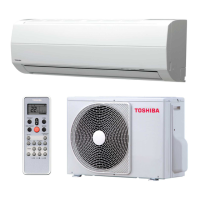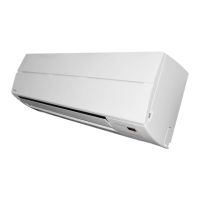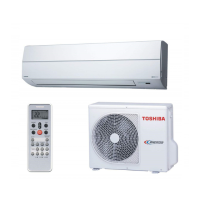
Do you have a question about the Toshiba RAS-18SKHP-ES and is the answer not in the manual?
| Type | Split System |
|---|---|
| Cooling Capacity | 5.0 kW |
| Heating Capacity | 5.5 kW |
| Refrigerant | R32 |
| Energy Efficiency Ratio (EER) | 3.21 |
| Power Supply | 220-240V, 50Hz |
| Coefficient of Performance (COP) | 3.61 |
| Outdoor Unit Dimensions (W x H x D) | 780 x 550 x 290 mm |
| Noise Level (Outdoor) | 50 dB |
Detailed diagrams of the indoor unit's physical structure and dimensions.
Detailed diagrams of the outdoor unit's physical structure and dimensions.
Electrical wiring schematics for specific model series.
Electrical wiring schematics for other specific model series.
List of electrical components for indoor units of specific models.
List of electrical components for a specific outdoor unit model.
List of electrical components for another specific outdoor unit model.
List of electrical components for indoor units of different models.
List of electrical components for another specific outdoor unit model.
List of electrical components for another specific outdoor unit model.
Diagram illustrating the refrigerant flow for specific models.
Diagram illustrating the refrigerant flow for specific models.
Diagram illustrating the refrigerant flow for specific models.
Diagram illustrating the refrigerant flow for specific models.
Block diagram showing control signal flow for specific models.
Block diagram showing control signal flow for other models.
Detailed explanation of the remote control's functions and buttons.
Explanation of the indicators and symbols shown on the remote control display.
Overview of how the indoor and outdoor units control the air conditioner's functions.
Explains how the unit operates in different modes like Cooling, Dry, Fan only.
Details on built-in safety features and operational limits.
Explanation of the fully automated operation mode for user comfort.
Describes the high-power mode for rapid cooling or heating.
Explains the quiet mode for reduced noise levels.
Details the energy-saving ECO mode for reduced power consumption.
Describes the comfort sleep mode for optimized temperature and auto shut-down.
Information on the filter indicator and how to reset it after cleaning.
Explains the function that allows the unit to restart after a power failure.
Describes the operation to clean the unit's interior by running the fan.
Essential safety warnings and precautions for installation.
Visual guide showing placement and mounting requirements for units.
General guidance and parts required for the installation process.
List of optional parts required for installation.
List of included accessories and parts for installation.
Lists tools required for installation and servicing of the unit.
Detailed procedures and considerations for installing the indoor unit.
Guidelines for selecting an appropriate location for the indoor unit.
Instructions for drilling holes and mounting the installation plate.
Guidance on electrical connections and power supply requirements.
Steps for connecting the indoor unit's wiring.
Instructions for installing refrigerant pipes and drain hoses.
Procedures for physically mounting the indoor unit onto the installation plate.
Instructions for ensuring proper drainage from the indoor unit.
Detailed procedures and considerations for installing the outdoor unit.
Guidelines for selecting an appropriate location for the outdoor unit.
Detailed steps for connecting the refrigerant pipes.
Procedures for evacuating air from the refrigerant system.
Steps for connecting the outdoor unit's wiring to the indoor unit.
Procedures for initial testing and setup after installation.
Procedure to check for refrigerant leaks after installation.
Steps to perform initial testing of the installed unit.
Instructions on how to configure the auto-restart function.
Guide for setting remote control mode when multiple units are present.
General steps for diagnosing issues with the air conditioner.
Initial checks to perform before detailed troubleshooting.
Guide for initial diagnosis based on unit behavior and indicators.
Using the remote control to access diagnostic codes for fault identification.
Flowcharts and guidance for diagnosing specific faulty components.
Specific troubleshooting steps for indoor unit problems.
Steps to diagnose issues related to wiring and signal transmission.
Procedures for checking and diagnosing the main control boards.
Steps to diagnose and resolve issues with the remote controller.
Step-by-step instructions for replacing parts of the indoor unit.
Step-by-step instructions for replacing parts of the outdoor unit.
Exploded view and parts list for the indoor unit's electrical assembly.
Exploded view and parts list for the indoor unit's main components.
Exploded view and parts list for specific outdoor unit models.
Exploded view and parts list for other outdoor unit models.










